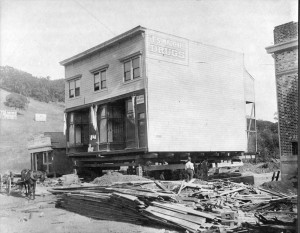Marin Herald, April 12, 1934
Incidents of Early Marin History
By Donald Perry
In the late ’70s San Anselmo did not exist. In the early ’80s there were perhaps a dozen houses in what is now known as San Anselmo. The railroad first ran to San Quentin, where it met a ferry boat operated by a man named Mintern. At that time the local station was known as Tamalpais. The railroad was extended down to Sausalito in the year 1875 and it was not until May 3, 1884, that the other railroad, known as the Donahue broad-gauge, was extended from San Rafael down to Tiburon. When the local line, known as the narrow-gauge, was extended to Sausalito, Kentfield station was then known as Tamalpais station, and the named ceased to exist at our local station and the name San Anselmo sprang into existence about that time.
All the property owners in San Anselmo south of Yolanda court derived title directly or indirectly from the Ross family. The whole valley was known as Ross valley. Among the earlier families coming to this valley were Barber, Dibblee, Tompkins, Col. Hoffman, Latham, Taylor, Carrigan, Brennfleck, Crisp, Foss, Mulverhill, Sousa, Butler, who were tenants of Sidney Smith, to whom Mrs. Worn, one of the Ross heirs, had sold 100 acres on which Michael Butler operated a dairy ranch. Smith sold this acreage to Raymond and Croker, who subdivided it into what now comprises Ross Valley Tract.
In 1845 there was only one house in San Rafael aside from the old mission establishment, hence there was little history aside from that of the mission prior to these times. The registered population of foreigners in the whole of California was only 380 in the year 1840, and by 1845 there were only 420 foreigners in the state, and shortly after that there were 680 male foreigners. It was about 1850 when the state came into possession of the Americans. and it was several years later before any orderly government came into existence. The Ross family was about the first family to erect a permanent home in the Ross valley. The Barber family came in 1866, and the Kents about 1873.
San Anselmo commenced to assume town proportions about 1895, shortly after the Seminary buildings were completed. Ross avenue was looked upon as the coming business street. Hund’s drug store was located opposite where the Odd Fellows building now stands. Hank Foote wanted to start a bank where Wessell’s garage now stands, but William Barr asked too much for the lot, so Foote built the building where Allen-Christensen are doing business at the corner of Bank street and Sir Francis Drake boulevard.

Building Being Moved, 1911
Fred Croker owned the building where the Hund drug store was, and when business commenced to center near the station, he moved the large frame building to Bank street and it was rented to the telephone company and now Jenness & McElroy occupy the same.
Mr. Tunstead gave the site of the Town Hall structure to the town after incorporation, and he cut through Oak street, later known as San Anselmo avenue, and thus the present business section was established.
Prior to those times, the older settlers, mainly widows, who owned two-thirds of the valley, were opposed to incorporation, but their opposition was of no effect, as women had no votes back in those times, and in January 1907, by a few votes, the town was incorporated.
Many people came here after the earthquake and fire in 1906, and although many returned afterwards to San Francisco when things began to look up over there, others remained here.
The Linda Vista Tract was put on the market in 1907. The Barber Tract was subdivided in July 1904 and the same year the Ross Valley Villa Tract lots were put on the market. San Anselmo was the first town to incorporate. Ross and Larkspur followed the following spring (1908). The Winship Tract was not subdivided until 1912. The Linda Vista Hotel, near Cedar street, was the former home of the Lathams, Allens, and Colonel Hoffman prior to their families building for themselves. The Tompkins family followed the Barbers, and they preceded the Dibblees by a few months. Later the Allens built the home where J. K. Armsby now is in Ross. After the earthquake the breadline was supplied from a butcher shop which stood where the Union Oil service station is now.

